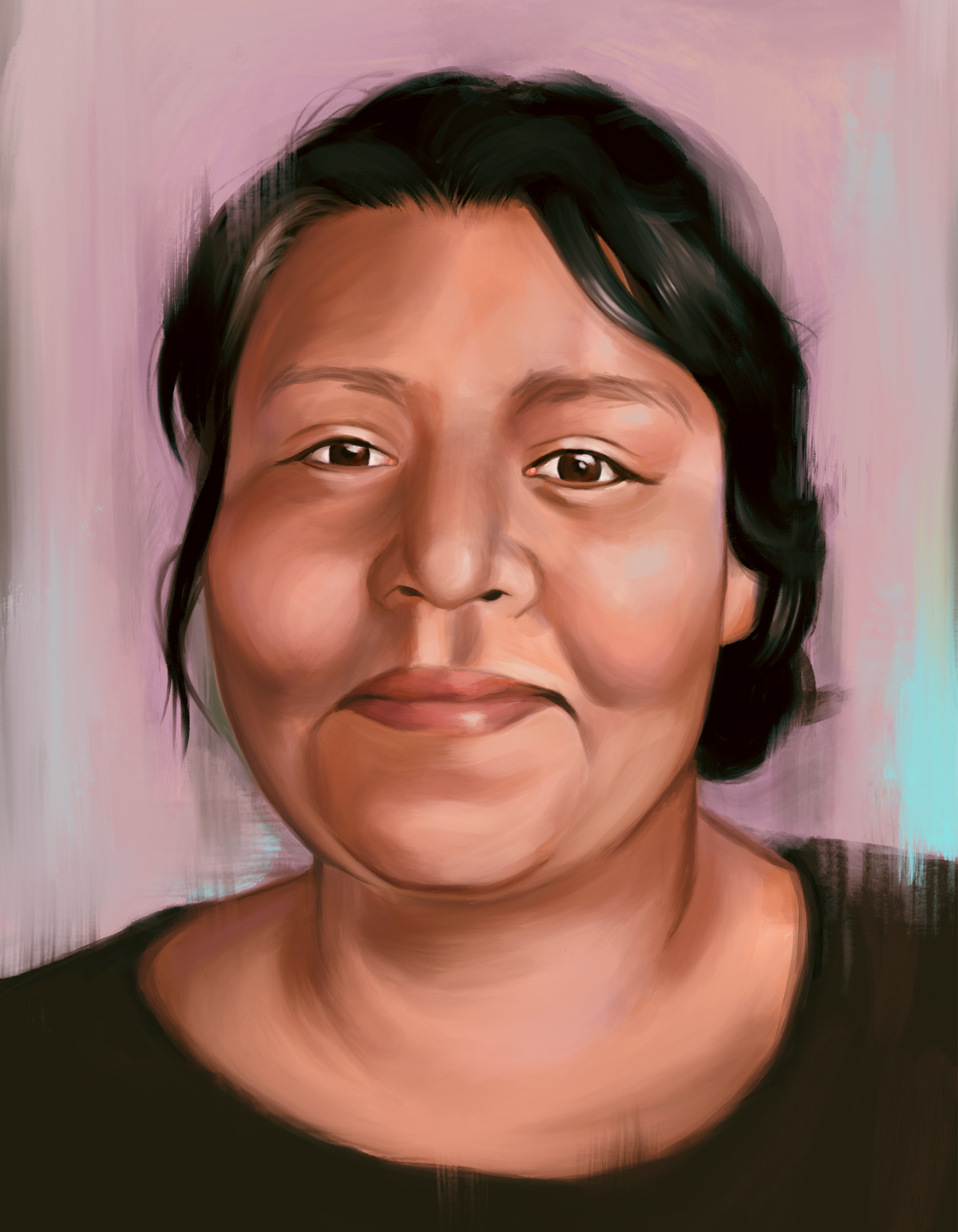JUSTICE
Looking for Justice,
Finding Betrayal
When Brayden Bushby was charged with the death of Barbara Kentner,
Indigenous faith in Canada’s legal system was put to the test
BY EVA HOLLAND
PORTRAIT BY LAUREN CRAZYBULL
ADDITIONAL ILLUSTRATIONS BY NATALIE VINEBERG
Published 04:56 pm, June 01, 2021
On November 2, 2020, Brayden Bushby walked into a makeshift courthouse wearing a dark suit and a matching dark mask. He was heavy-set, broad in shoulders and chest, but shorter than either of his lawyers, who bracketed him as they passed the media’s cameras.
It was the first day of his trial. There had been months of delays, ranging from routine legal considerations to the surreal: a pandemic and then an electrical fire that shut down the Thunder Bay courthouse. Now, finally, in a repurposed hotel ballroom divided by sheets of Plexiglas, Bushby’s case was called to order. The traditional phrases announcing the opening of a court of law (“Oyez! Oyez! Oyez!”) sat strangely alongside justice Helen Pierce’s apologies for any glitches in the technology zooming the trial to screens across the country. After the preliminaries, Bushby stepped out of his box to stand behind the defence table with his lawyers. A court official read out the two counts against him, to which Bushby was asked to plead guilty or not guilty. To the charge of manslaughter against an Anishinaabe woman named Barbara Kentner, Bushby responded, in a clear voice, “Not guilty.” His response was recorded, and then the clerk read out the second charge: aggravated assault against Kentner. “Guilty,” Bushby said.
“You have pleaded not guilty to count one and guilty to count two. Is this correct?”
Bushby agreed.
“Are you ready to proceed with your trial?”
“Yes,” he said.

And that was it. Bushby wouldn’t speak again on the record. His guilty plea to aggravated assault swept aside any disagreement over the basic events of January 29, 2017. By admitting his guilt, Bushby admitted that the crime involved a car full of teens and a night of aimless driving after a day that Bushby, for one, had spent drinking straight from a two-six of whisky. He admitted that, in the early hours of the morning in question, the vehicle had rolled down McKenzie Street, a quiet stretch of road in Thunder Bay. He admitted that he had climbed halfway out of the passenger window, clutching a trailer hitch he had stolen off a truck earlier that night. And that, as his friend had driven past two women walking on the road—Melissa Kentner first, followed by her sister Barbara—Bushby had hurled the trailer hitch, striking Barbara in the stomach. And finally that, as Barbara had doubled over in pain, she and her sister had heard him call out, “I got one.”
None of these details were being disputed, so the prosecution would not have to prove the facts of the attack. Bushby’s plea of not guilty to the charge of manslaughter, however, meant that the Crown would have to prove his role in what came afterward: Barbara Kentner’s decline over the following five months and her eventual death, on July 4. In the Canadian Criminal Code, manslaughter is classified as a form of homicide, but its incarnations range widely, from what may be termed near-accidents to near-murders. Typically, it involves an unlawful act that plays a significant role in a person’s death, where bodily harm from the act was foreseeable. It requires no planning or deliberation and no intent to kill. But it does require that a crime be committed. Accidentally hit and kill a pedestrian as you drive the speed limit, running no red lights? Not man-slaughter. Punch someone in a bar brawl and their head strikes the edge of a table, sending them into a fatal coma? Textbook manslaughter.
Bushby and his legal team, however, didn’t accept that his actions had played a significant role in Kentner’s death. A criminal trial is about duelling narratives—the most convincing story wins. The story Bushby’s lawyers wanted to tell went like this: yes, their client had committed a terrible, violent act, but Kentner had come through it and had been on track to recover before dying of liver disease, a diagnosis that predated the attack. The prosecutors, for their part, wanted to counter with a story about an assault with cascading medical consequences from which Kentner never recovered. She would have lived longer, they would argue, if she had never crossed paths with Bushby.
The trial would be a mirror held up to Canadian society. Staring back was not only the broader colonial system of law and its consistent failure to provide justice for Indigenous people but also the way racism operates on a dangerous continuum: from contempt and derision to violence and murder. But, while the issues in play would be broad, the field of debate would be narrow. The trial would not turn on eyewitness testimony or incriminating documents. Instead, it would hinge on the story told by Barbara Kentner’s body.

Brayden Bushby’s trial was the latest in a series of high-profile homicide cases featuring an Indigenous victim and a white defendant. The results—acquittal after acquittal—were devastating to many onlookers. In 2015, an Edmonton jury (described as “visibly white” by CBC News) found Bradley Barton not guilty of first-degree murder for the death of Cindy Gladue, a thirty-six-year-old Cree and Métis woman who had bled to death in Barton’s hotel room. Jurors could instead have found him guilty of the lesser charge of manslaughter, but they chose not to.
Then there was Tina Fontaine, a fifteen-year-old girl from Sagkeeng First Nation whose body was found in the Red River in 2014, wrapped in a duvet cover and a plastic bag and weighed down with rocks. The suspect in her killing—Raymond Cormier, charged with second-degree murder—was also found not guilty. The fact that Fontaine was supposed to be in the custody of Manitoba’s Child and Family Services when she died only drove home the inadequacy and abuse Indigenous children have too often received from Canadian institutions. Fontaine was, in fact, one of hundreds of missing and murdered Indigenous women and girls, and her death led to a national inquiry that toured the country collecting stories about cases that are too rarely fully investigated or vigorously prosecuted, stories of lives taken with impunity.
Listen to an audio version of this story
For more audio from The Walrus, subscribe to AMI-audio podcasts on iTunes.
During the same week, in early 2018, that the Cormier trial began in Manitoba, yet another trial was underway one province west—a trial that would prove consequential for the prosecution of Barbara Kentner’s death. In North Battleford, Saskatchewan, a white farmer named Gerald Stanley stood accused of second-degree murder in the shooting death of a Cree man named Colten Boushie. At the time of his death, the twenty-two-year-old was sitting in a vehicle one of his friends had driven onto Stanley’s farm. That circumstance was explored in Storying Violence: Unravelling Colonial Narratives in the Stanley Trial. According to authors Gina Starblanket and Dallas Hunt, Boushie’s presence on Stanley’s property tapped into potent Prairie mythologies of soil and settlement, self-reliance and self-defence—the frontier notion of farmers defending “their” land against Indigenous incursion. Those mythologies fed public support for Stanley among white residents—and vitriol toward the victim. (“His only mistake was leaving three witnesses,” wrote one Facebook user, who turned out to be a rural municipal councillor in Saskatchewan. Then-premier Brad Wall wound up making a public plea for an end to racist online comments about the case.)
Stanley admitted the bullet that had struck Boushie in the head and killed him was fired from a gun he held, but he claimed that the discharge had been an accident. If they were not convinced of his deadly intentions, Stanley’s jurors, like Barton’s, had the option to convict him on the lesser charge of manslaughter. Instead, like Barton, Stanley walked free.
The result sparked anger across the country. Rallies were held in Saskatoon, Regina, Edmonton, and Toronto. Social media lit up with shock—even prime minister Justin Trudeau and then-justice minister Jody Wilson-Raybould tweeted their reactions to the verdict. In Maclean’s, Stanley’s acquittal was called “a great leap backward” for reconciliation and proof that “in the eyes of Canada’s justice system it is okay to shoot and kill an unarmed Indigenous man.” The uproar also increased the scrutiny of how Canadian juries are selected. Stanley’s defence team had purged all visibly Indigenous potential jurors from the pool using a mechanism called a peremptory challenge, which required no reason or rationale to be given for the dismissal and which could not itself be challenged or appealed. It was, effectively, a veto. Prosecution and defence each had a maximum of fourteen peremptories at their disposal; Stanley’s team needed only five to achieve an all-white jury.

The legal tool has been criticized in Canada for decades. In 1991, judges Murray Sinclair and Alvin Hamilton addressed the issue in the report of the Manitoba Aboriginal Justice Inquiry, which had been prompted, in part, by the discriminatory use of peremptory challenges during a 1987 trial for the brutal killing of a young Cree woman named Helen Betty Osborne (only one of the four men charged was ever convicted). “Unfortunately, the jury selection process designed in our Criminal Code and Jury Act allows such practices to occur,” they wrote. “We believe that such practices should no longer be allowed.” More than twenty years later, retired Supreme Court judge Frank Iacobucci compiled a report on the justice system’s relationship to First Nations: what he found, he wrote, was “a crisis.” Among his recommendations was amending the Criminal Code to “prevent the use of peremptory challenges to discriminate against First Nations people serving on juries.” The pleas for change piled up, but no government acted on them.
Stanley’s acquittal hung over the prospect of a Bushby trial. With Thunder Bay’s growing national reputation for anti-Indigenous hate crimes and a series of reports that had found systemic discrimination in the police service, it was easy to imagine that Bushby might face a similarly monochromatic jury. Instead, in the weeks after Stanley walked out of court, the federal government introduced Bill C-75, which proposed an array of changes to the Criminal Code and to various other parts of the justice system. It included several changes to the jury-selection process; most notably, it abolished peremptory challenges, a move supported by organizations like Aboriginal Legal Services, a legal-aid clinic for Indigenous people living in Ontario, and the David Asper Centre for Constitutional Rights, an advocacy group.
Bill C-75 received royal assent on June 21, 2019, but was promptly challenged in court. The decision to remove peremptories was opposed by many defence attorneys, who object to any shrinking of an accused’s rights in court. Groups representing Muslim, Black, and Asian lawyers argued that the removal would end up harming marginalized or racialized defendants in the end. The tool, they said, was necessary to allow their clients to weed out jurors with racial animus toward them. But law professor Kent Roach, who published a book about the Gerald Stanley and Colten Boushie case and argued for abolishing the peremptory challenge, thinks there are better ways to guard against prejudice on Canadian juries. For example, there’s challenge for cause. This mechanism can be used to remove jurors who are found to be incapable of impartiality. Where peremptory challenges required no explanation or justification, challenge for cause requires jurors to answer a set of questions, agreed upon ahead of time by judge and lawyers, that are used to assess their impartiality.
It was the uncertainty over the fate of peremptory challenges that led to the postponement of Bushby’s trial, originally scheduled for January 2020, as the lawyers waited to learn whether they could use peremptories or not. Last October, the Supreme Court of Canada upheld the change and ruled that it applied even to cases already underway.
By then, for Bushby, the point was moot. In September, the prosecutors in Thunder Bay announced that Bushby would now face a charge of manslaughter rather than of second-degree murder. And he would do so not in a jury trial, as planned, but in front of a judge alone.
The move was, as Bushby’s senior defence counsel, George Joseph, explained in an interview months later, “a bit of a quid pro quo.” Both sides wanted to avoid further delays and the risks of placing twelve jurors in close proximity to one another during a pandemic. And both sides were worried about media exposure in their prospective jury pool. The case had received extensive news coverage and had generated heated and often racist debate online. The Crown, says Joseph, was concerned “that we would get a certain type of jurist who would see the victim as less worthy of sympathy”; Joseph, for his part, was worried about jurors who would be determined to “make Brayden Bushby a scapegoat to atone for the sins of Thunder Bay.” So, he says, they came to an agreement: Bushby would waive his right to a trial by jury and plead guilty to the initial charge of aggravated assault. In exchange, he would be tried on a charge of manslaughter instead of second-degree murder.
In March, the Kentner family told the media that Barbara would never recover from her injuries—that she was dying.
His guilty plea to aggravated assault guaranteed the Crown some form of conviction: even if he were acquitted of manslaughter, he would still be guilty of the attack itself, and he would face a maximum of fourteen years in prison for that crime. The Crown also now had a much lower legal threshold to secure a conviction because the bar is lower for manslaughter than for murder.
Reflecting the range of crimes it encompasses, manslaughter is the most serious violent charge not to carry a mandatory minimum sentence. Judges have the discretion to assign a defendant anything from simple probation to life in prison. Second-degree murder, in contrast, carries a mandatory minimum sentence of life, at least ten years of which are without the possibility of parole. So, while it was true that, by agreeing to the lesser charge of manslaughter, Bushby faced an increased chance of conviction, he also now faced a better shot at a shorter sentence.
To many onlookers, the change from second-degree murder to manslaughter felt like another sign of disrespect for Indigenous lives. To lawyers, it was just lawyering. “It’s a common tactic for Crown attorneys to overcharge in murder cases,” says Joseph. “And the reason for that is they get some bargaining power if it comes to plea time.”
Andrew Sadler, the Thunder Bay Crown attorney who led the Bushby prosecution, acknowledged in court that he did not relish the prospect of proving Bushby’s state of mind given the evidence of him puking before his attack on Kentner. A murder charge would have required that Sadler prove Bushby’s “subjective foresight” of the outcome—that he either knew or should reasonably have known that his actions could cause death—a seemingly achievable feat given the cold, dense metal of the trailer hitch in his hands. But it also would have allowed the defence team to invoke Bushby’s intoxication and marshal it as evidence to help relieve him of responsibility. Manslaughter is different, Sadler said. Level of intoxication is not a factor. In other words: there is no such thing as being too drunk to commit manslaughter.
“That’s an example of the Crown doing their job,” says Naomi Sayers, an Indigenous lawyer based in Sault Ste. Marie, of the shift to manslaughter. She seemed doubtful about second-degree murder making its way to conviction. “Would they have met the elements of a murder charge? Probably not. And then everybody would have been outraged.”
On that first November morning in hotel-court, Sadler rose to make his case. And the case, he explained, was about causation. Under Canadian law, Bushby could be convicted of manslaughter if his unlawful act—the throwing of the trailer hitch—contributed significantly to Barbara Kentner’s death. It did not have to represent her sole cause of death or even her primary cause of death. The act had to cross beyond what Sadler called the de minimus threshold—the Latin legal term for “insignificant.” The Criminal Code doesn’t draw the line between insignificance and significance. Instead, lawyers and judges rely on precedent to make that determination. Sadler would make his argument using the available scientific evidence about Kentner’s cause of death and the available case law that suggested how a judge ought to interpret and apply that evidence in reaching a verdict.
Given the narrowness of the question at issue, the prosecution called just two witnesses. The first was Melissa, Barbara Kentner’s sister. While she could not speak to medical causation, her testimony set the scene of the attack and helped bring a sense of Barbara—the living woman, not the body under scrutiny—into the courtroom.

Melissa, solemn and dressed all in black, described how, around 1 a.m. on January 29, 2017, she had noticed a dark vehicle roll by on McKenzie Street. How she heard a “clank-clank” and turned around to find Barbara doubled over, holding her stomach. How she backtracked to her sister and found the source of her pain: a trailer hitch lying in the street. How she gathered up the heavy object, carefully, with her sleeve (the sisters would eventually slip it into a plastic bag to bring to the police) and helped Barbara off the street and out of sight in case their attackers circled back. After she saw her uncle drive by, she called him on her cellphone to turn around and pick them up. He drove both sisters back to Barbara’s place, nearby, where they tried to get a few hours of sleep. Later that morning, a third Kentner sister, Cheryl, drove them all to Thunder Bay’s hospital, where staff diagnosed a perforation in Barbara’s small intestine and she underwent emergency surgery.
From there, most people watching and listening knew the rest of the story. Barbara’s hospital visits piled up. In March, the Kentner family told the media that Barbara would never recover from her injuries—that she was dying. Police paid Barbara a house call to record a video statement, anticipating that she would not be able to testify at her attacker’s eventual trial. And, early that summer, Barbara entered hospice care. She died in the early morning of July 4. She was thirty-four years old and left behind a teenage daughter.
Toby Rose, a forensic pathologist, was up next. It was her testimony that would speak to medical-legal causation: the case hinged on what she had to say. At the time that she had conducted the autopsy on Kentner, Rose was Ontario’s deputy chief forensic pathologist. She had decades of experience, having performed thousands of autopsies in her career. Her task was to determine a cause of death, and her finding, as she explained in court, was much more complex than it would have been in the case of, say, a gunshot wound to the head.
Rose told a story about consequences: the blunt force impact of the trailer hitch as the start of a chain reaction. Her testimony was densely technical. She had combed through a box of Kentner’s medical records from before and after the attack. She had inspected Kentner’s body, doing an external exam as well as the autopsy. Tissues and fluids had been examined. Over the course of several hours, Rose outlined the key points that had led to her conclusion, each one more intimate than the last. The injury and the surgery together had led to complications, to which Kentner had been particularly vulnerable given her pre-attack diagnosis of cirrhosis. She was, Rose acknowledged repeatedly, already “a very sick woman” when she was hit. But Rose’s investigation had led her to conclude that being hit with the trailer hitch had shortened Kentner’s life still further.
In Rose’s cross-examination, there were tense moments. The defence had no route to acquittal, after all, except to sow doubt around her findings. Wasn’t the way Kentner had died, defence lawyer George Joseph argued, awfully similar to the way one dies from liver disease? Joseph entered into evidence the mental health records from her hospital stay after the attack, suggesting that notes from a psychiatric consultation showed her displaying “confused thinking,” a symptom of end-stage liver disease. Wasn’t this, he implied, a sign that she had already been close to death? In reply, Rose noted firmly that, on the very next page, the psychiatrist had attributed the “confused thinking” to other factors.
Yes, she agreed under Joseph’s questioning, it was a complex case. But she had seen others as complex in her career. And, yes, she acknowledged, it was possible that some other pathologist would have reached some differing conclusion. She stood by her own findings.
Sadler pushed back against Joseph. Speculation, he argued, is not good enough; hypothetical alternative narratives, proffered without proof, are not good enough. The defence’s counterstory needed evidence. He introduced another legal concept: the “thin skull rule,” the idea that an assailant is liable for any injury they cause even if the victim had a preexisting condition that made them more vulnerable. For instance, if you stabbed someone whose blood didn’t clot well, you would be just as responsible for their death as had you killed someone who bled more slowly. So, Sadler argued, Kentner’s medical condition did nothing to alleviate Bushby’s guilt in her death. “It matters not whether there were other causes unrelated to the injury, as long as the Court is satisfied that the injury played a role beyond de minimus,” he said.”
He urged the judge to accept Rose’s finding of causation: a leads to b leads to c. But we can trace that line of causation even further back, to before the moment of impact, can’t we?
One of Thunder Bay’s cruelties is the practice of throwing makeshift missiles—beer bottles, pop cans, food wrappers, and other litter—at Indigenous pedestrians from a moving vehicle. The city of 127,000 on Lake Superior’s northwestern shore is the urban hub for dozens of First Nations whose territories span northwestern Ontario. For decades, their citizens have reported the phenomenon. “We would get egged by white kids,” one Indigenous youth told journalist Tanya Talaga in her book Seven Fallen Feathers, about the unexplained deaths of seven Indigenous students. (The students had attended high school in the city, far from their communities.)
When activists say that “racism kills,” this is, in part, what they mean—not a metaphor, not hyperbole.
When Melissa Kentner first wrote about the attack on Facebook, the post hummed from one screen to the next. Thunder Bay police caught wind of it, as did local media. The first news stories appeared online, from CBC Thunder Bay and APTN, and rapidly began to spread across the country, where the attack was received as an aberration—a strange, macabre crime that goes viral. In Thunder Bay, it was understood not as an outlier but as an escalation.
Bushby, whatever his state of mind, had not picked up that trailer hitch in a vacuum. His actions mirrored the society he was raised in, just as our court system so often reflects our failings back at us. In a city where missiles are thrown from vehicles, in a country where Indigenous women are disproportionately likely to be killed, an Indigenous woman was killed by a missile thrown from a vehicle. There’s a cold, causal logic there. When activists say that “racism kills,” this is, in part, what they mean—not a metaphor, not hyperbole. It’s an ecosystem of stereotypes and bad jokes that evolve into slurs and taunts, then eggings and tossed trash, then worse. The Bushby case was, in a way, itself a dense object thrown from a moving vehicle: heavy with velocity and kinetic energy even before its release. Finally, in the trial, it reached the point of impact.
At the end of Brayden Bushby’s four-day trial, the judge and the lawyers deliberated about which exhibits—the documents and other items entered as evidence throughout the proceedings—journalists covering the case would be permitted to see. Everything that is spoken out loud in court is transcribed and written into the public record, but access to exhibits can be limited. Justice Pierce noted that, while she was mindful of the principles of open courts, she wanted to hear from both legal teams about holding back some details for the sake of Barbara Kentner’s dignity. She invoked a recent precedent: R. v. Barton.
Bradley Barton was the man charged with the first-degree murder of Cindy Gladue. Gladue had bled to death from an eleven-centimetre wound in her vaginal wall—a victim of some form of stabbing, the prosecution argued in Barton’s first trial; his defence claimed he had inadvertently caused the injury with his hand and fingers during consensual “rough sex.” That trial featured the ghoulish presentation of Gladue’s vaginal tissue to the court and the jury—the prosecution’s effort to drive home the extent of the wound and the improbability of it having been caused by a consensual accident. But even this violation was not enough, and Barton was acquitted.
The prosecution appealed, arguing that the judge had erred significantly and that Barton should be retried. The Criminal Code, for example, forbids the use of a victim’s previous sexual history to suggest that consent was given; the judge, lawyers said, had failed to enforce that rule and had never instructed the jury to ignore those implications.
The appeal eventually went on to the Supreme Court of Canada, where the justices decided that the trial judge had indeed made errors and offered a series of guidelines to avoid those mistakes in the future. “Our criminal justice system and all participants within it,” they wrote in their judgment, “should take reasonable steps to address systemic biases, prejudices, and stereotypes against Indigenous women and sex workers.” The justices then ordered a new trial.
Barton now represented a sort of precedent in reverse: a manual on what not to do and a symbol of the legal system’s new attempt to uphold, in the courtroom, the dignity of Indigenous women who were victims of crime.
The Barton judgment focused specifically on sexual assault cases, but Pierce wanted to bear the broader principle in mind. She recognized a continuum from one woman’s tissue to another’s intimate medical details, and she was concerned that public access to Barbara Kentner’s medical records might expose her to further racism and stereotyping. “It is hard to imagine more intrusive information,” she noted. After the matter of the exhibits was dealt with and the lawyers had had their say, Pierce reserved her decision: she would offer a verdict, with detailed reasoning, on December 14.
Five weeks passed before the lawyers and other officials reconvened to hear the judge’s verdict. She spoke for more than an hour. She accepted Rose’s findings of causation and did not accept the various arguments the defence had put to her. She found Brayden Bushby guilty, beyond a reasonable doubt, of manslaughter in the death of Barbara Kentner.
That’s an easy narrative for Canadians to embrace: We’re getting better. But there is little to celebrate in the bare minimum being achieved.
At a sentencing hearing on February 17, prosecutors argued that Bushby should serve eight to twelve years in a federal penitentiary. His defence attorneys argued for a sentence of four years. (Had Bushby been convicted of second-degree murder, there would have been no argument: an automatic life sentence would have been applied.) The sentencing decision is scheduled for June 7.
It may be tempting to view Bushby’s conviction as the start of a pattern, to plot it as one point on a graph. After all, in February, while lawyers argued over Bushby’s sentence, Barton also faced a new trial in the death of Cindy Gladue. This time, her bodily tissue was not put on public display. This time, Barton, too, was convicted of manslaughter. Was this not part of a line trending up, a system improving itself? That’s an easy narrative for Canadians to embrace. We’re getting better. But there is little to celebrate in the bare minimum being achieved: in prosecutors doing their jobs; in a judge or jury finding their way to a verdict that appears to match the evidence arrayed before them. A story about improvement, about redemption, is too simple, too self-congratulatory.
Beverly Jacobs is the associate dean of law at the University of Windsor and a longtime advocate for missing and murdered Indigenous women and girls. The abolition of peremptory challenges was, she believes, cosmetic, and she argues that the criminal legal system needs to be reenvisioned in ways that are not inherently adversarial. “It’s a game,” she says, referring to the theatre of clashing narratives and cross-examination at play in Canadian courtrooms. “It’s a game between the defence counsel and the Crown attorneys.”
Bill C-75 may be of some help, she allows, but it doesn’t address a colonial process that’s been forced upon Indigenous people or the way the system can dehumanize victims. “The whole system,” she says, “was designed to try to erase Indigenous people from the beginning.” Jacobs teaches her students that it doesn’t have to be that way, that it’s possible to practise greater respect in the courtroom, not only for the dignity of Indigenous women but for everyone. There is room for compassion: we can build a system not so pulverizing of its participants. Just look at the training of criminal lawyers, she says. “There’s a mentality in that profession of being able to win for your client. It’s not about winning. It’s supposed to be about justice.”
It can feel hard to reimagine a system so embedded in our society, though. And the stakes are high. In the closing hours of the Bushby trial, Joseph expressed regret for the argument he was about to advance: that Barbara Kentner might have lived longer if her sister Melissa had taken her to the hospital immediately after the attack instead of waiting until the next day. It was the kind of argument that landed cruelly for onlookers. Still, according to Joseph, it had to be made. “I’d be inhuman if I didn’t know that this was a sister who was grieving the loss of her sister,” he said recently. “To suggest that she played a role in that is a difficult suggestion to make but one that a diligent lawyer has to make.” Ryan Green, Joseph’s co-counsel, agrees that the process is tough. “It’s hard on people; it’s tough on witnesses; it’s hard on us, quite frankly. But even the slightest shift away from that rigorous process—of cross-examination, for example—could result in an innocent person going to jail.”
For Sayers, the Sault Ste. Marie lawyer, all attorneys have a duty to their clients. “It doesn’t go away just because somebody doesn’t like hearing something.” She acknowledges the pain cross-examination can cause: “It feels like an attack, it does. It feels like, Why are you blaming the family?” But, to her, the emphasis should be on preventing crimes like Bushby’s in the first place rather than on hemming in an accused’s legal defenders. “I think that just calls out to the responsibility of everybody in helping to stop violence against Indigenous women.”
But, for Jacobs, it remains possible—and essential—to tell a different story about the functioning of justice in this country. It starts with education, she says. Not just in law school but from childhood, to uproot harmful stereotypes about Indigenous people and to preempt the calcification of assumptions and attitudes. To build a culture that would never countenance decades of garbage launched from cars, that would value the lives of Indigenous women. “They call it a precedent,” she says of the principle of case law built upon case law, stories upon stories, that shapes our system. “Precedent can be changed.”
In the end, the Kentner family, the lawyers, and the judge agreed that the video exhibit, Kentner’s statement, should not be made public. The transcript of the tape was enough: it was her words, not her image three months before her death, that mattered.
In the video, an exhausted Kentner described that night on McKenzie Street (“I felt something hard hit me”) and the hours that followed (“I couldn’t breathe, I couldn’t sleep”). At the end of the clip, she began one final sentence, “It really sucks—” and was cut off, the video edited by prior agreement among the lawyers. In our system, witnesses are allowed to share statements of fact with the court, to tell the story of what occurred, but they are not permitted to air what may be termed an opinion. Before the cut was made, in the full version of the video, she finished the thought: “I’m gonna lose my life because of it.”
The reporting for this story was supported by the IWMF’s Howard G. Buffett Fund for Women Journalists.





